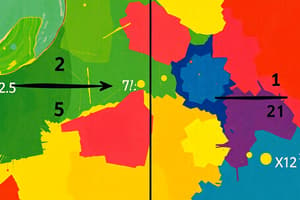Podcast
Questions and Answers
What is the numerator in the fraction 3/5?
What is the numerator in the fraction 3/5?
- 4
- 5
- 3 (correct)
- 2
To compare fractions directly, what key step should be taken if they have the same denominator?
To compare fractions directly, what key step should be taken if they have the same denominator?
- Subtract the denominators
- Add the numerators
- Convert them to decimal form
- Find equivalent fractions with the same denominator (correct)
In comparing fractions like 2/5 and 7/5, what do like fractions share?
In comparing fractions like 2/5 and 7/5, what do like fractions share?
- Same value
- Same numerator
- Same denominator (correct)
- Same size
What does the denominator of a fraction represent?
What does the denominator of a fraction represent?
If 4/7 is compared with 5/7, what would be a correct statement?
If 4/7 is compared with 5/7, what would be a correct statement?
When comparing fractions with the same denominator, how can you determine which fraction is greater?
When comparing fractions with the same denominator, how can you determine which fraction is greater?
In a fraction circle, what does each part of the circle represent?
In a fraction circle, what does each part of the circle represent?
Why is it important to divide a whole into equal parts when representing fractions?
Why is it important to divide a whole into equal parts when representing fractions?
What is one benefit of using fraction bars to represent fractions?
What is one benefit of using fraction bars to represent fractions?
How do fractions of a whole help in understanding more complex fraction concepts?
How do fractions of a whole help in understanding more complex fraction concepts?
Study Notes
Fractions
A fraction is a part of a whole. It consists of two parts: a numerator and a denominator. The value of a fraction depends on both these parts. For example, in the fraction \( \frac{3}{5} \), the top number (3) is called the numerator and the bottom number (5) is called the denominator.
Comparing Fractions
Comparing fractions involves determining their relative size. If one fraction has a larger numerator than another, it represents a larger piece of the whole. However, if they have the same denominator, you can compare them by finding equivalent fractions with the same denominator. Here's how you compare fractions:
-
Compare with the Same Denominator: To compare fractions directly, find equivalent fractions with the same denominator. Then, compare the numerators.
- Example: Compare
\( \frac{3}{4} \)and\( \frac{5}{4} \). Find equivalent fractions with denominator 10. So,\( \frac{3}{4} \)becomes\( \frac{3 * 2}{4 * 2} = \frac{6}{8} \), while\( \frac{5}{4} \)becomes\( \frac{5 * 3}{4 * 3} = \frac{15}{12} \). Now you can compare them directly:\( \frac{15}{12} > \frac{6}{8} \). Therefore,\( \frac{5}{4} > \frac{3}{4} \).
- Example: Compare
-
Compare "Like" Fractions: Like fractions are fractions that share the same denominator. They represent equal parts of the same whole. Compare like fractions by comparing their numerators.
- Example: Compare
\( \frac{2}{5} \)and\( \frac{7}{5} \). Both fractions have the same denominator, so you can compare their numerators directly:\( \frac{2}{5} < \frac{7}{5} \). Therefore,\( \frac{7}{5} > \frac{2}{5} \).
- Example: Compare
Fractions of a Whole
Fractions of a whole represent parts of a single unit. The concept is often introduced using fraction circles or fraction bars. You divide the circle into equal parts called fractions. For example, if a circle is divided into fourths, the four pieces represent the fractions \( \frac{1}{4}, \frac{2}{4}, \frac{3}{4}, \frac{4}{4} \). These fractions add up to 1, which represents the whole circle.
Fraction Circles
In a fraction circle, a whole circle is divided into equal parts. Each part represents one fraction of the whole. By connecting the center point to each part, you create a line that divides the circle equally. This visual representation helps students understand fractions as parts of a whole.
Fraction Bars
Similar to fraction circles, fraction bars display fractions as parts of a whole. Instead of a circle, the whole is represented as a horizontal bar. As before, dividing the bar into equal parts creates fractions representing different portions of the whole.
Understanding fractions as parts of a whole is essential for understanding more complex fraction concepts, such as adding and subtracting fractions with different denominators. It also helps students grasp the relationship between fractions, decimals, and percentages.
Studying That Suits You
Use AI to generate personalized quizzes and flashcards to suit your learning preferences.
Description
Learn about fractions, which consist of a numerator and a denominator to represent parts of a whole. Discover how to compare fractions by analyzing their numerators and denominators. Explore the concept of like fractions and fractions of a whole using fraction circles and fraction bars.




